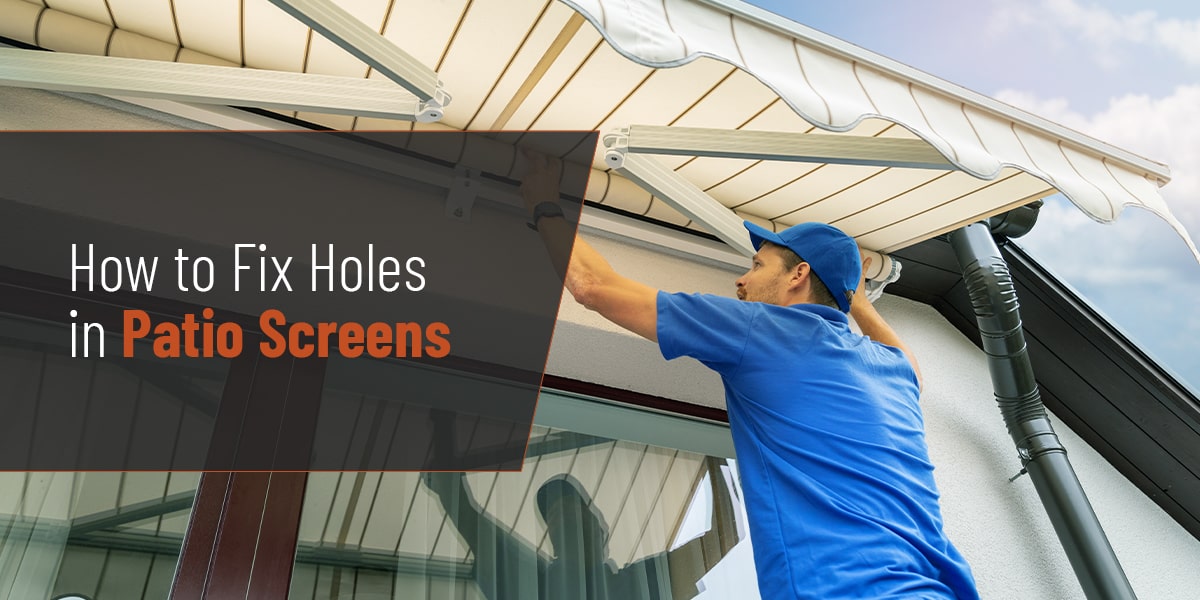
If your insect screen gets a hole, it can be patched easily. Shading Texas is more than happy to offer you a replacement mosquito screen but, if you’re looking for a quick fix instead, here’s what you can do.
The Steps
- Measure the ripped hole
- Cut out a new piece of screen
- Thread your upholstery needle with thread
- Adhere the Patch to the Screen
- Stitch the patch
- Double knot the final stitch
What You’ll Need
- Small roll of mosquito screen
- Scissors
- Upholstery Needle
- Thread that matches the color of your insect screen
- Measuring tape
1. Trim Damaged Screen to a Ravel-Free Square
When your mosquito screen gets a hole, the edges will begin to unravel, creating an uneven perimeter around the hole with many loose threads. To prepare the screen area for patching, trim off loose threads until you have a square with clean edges all around.
Learn More About Our Products2. Measure the Ripped Hole
Use the measuring tape to figure out how big the repair to your garage door screen will need to be. This step will help you decide how much material you need to patch the hole in your screen. Getting the dimensions as precise as possible will allow for a more seamless patch.
3. Cut Out a New Piece of Screen
Now that you have the measurements, take your scissors and cut out a patch of insect screen that matches the dimensions of the ripped portion of your screen. Leave a 1-inch margin around the new patch. Note: If you’re wondering where you can get a piece of screen, look for garage door screen repair patches. These kits are small and prevent you from having to purchase a roll of screen material to fix a small hole.
4. Thread Your Upholstery Needle With Thread
An upholstery needle’s curved structure will make threading the patch onto the screen much easier than a straight needle. Make sure the thread is securely in the needle. If you want, you can tie a small knot around the needle to guarantee strong thread. Also, the thread’s color should be as close to the original color of the screen as possible. Thread matching allows your patch to blend seamlessly into the surrounding screen. When choosing a thread, you should also ensure it’s heavy-duty and will hold up to battering over time.
5. Adhere the Patch to the Screen
Make sure the 1-inch margin is evenly spaced over the hole. You won’t want to leave a considerable margin on one side because you may not have enough material to patch the hole on the other side. If you need extra help, you can put the patch in place with clear adhesive tape. The tape will hold the patch in place while you stitch so you can free up both hands to focus on stitching. You may get small amounts of tape stuck in the thread, but it will make the patching more secure.
6. Stitch the Patch
Create a tight hold between the two patches using the needle and thread. Make sure the thread bonds the mosquito screen with the patch as tightly as possible, leaving out any slack in the thread.
7. Double Knot the Final Stitch
Double-tie a knot in the thread, creating a firm seal that will hold over the hole. Check to ensure there aren’t any holes around the patch’s perimeter where insects could get in.

How to Repair an Insect Screen Without Stitching
If you don’t want to spend the time stitching a patch to your insect screen, you can also look for adhesive screen patches. With these patches, you can use a heat source like a blow dryer to bond the patch to your screen. You’ll follow the same first three steps listed above, but instead of stitching, you can attach the new screen using heat.
Even if your patches don’t have adhesive built in, you can use an adhesive like super glue around the patch’s edges instead. If you use this method, you’ll want to ensure the patch and screen hold together well. You should also use extra caution to avoid creating uneven bumps with excess glue.
Need an Insect Screen Replacement?
An insect screen can make your outdoor spaces more liveable by keeping out mosquitos and other pests. Unfortunately, a hole can compromise the entire screen by providing an entrance for bugs. If you have a small hole, you might seek do-it-yourself repair options to get your screen back to working order.
If your hole is a bit bigger than what a mosquito screen repair can fix, contact Shading Texas. We offer insect screen replacement along with new installations, awningsand more.
Learn More About Our Products
Matt Pierce has been working in the solar shade industry for over 15 years, providing sun protection in the extremes of Alaska and Texas. His dedicated team at Shading Texas will get your the sun solutions you need to enjoy your patios and homes for years to come by blocking out bugs, sun, wind, and rain!
